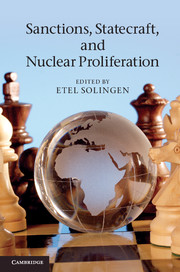Book contents
- Frontmatter
- Contents
- Figures
- Tables
- Contributors
- Preface and acknowledgments
- Part I Anatomy of inducements
- Part II Competing perspectives
- 5 An analytically eclectic approach to sanctions and nonproliferation
- 6 Threats for peace?
- Part III Reassessing the record: focused perspectives
- 7 Influencing Iran’s decisions on the nuclear program
- 8 Engaging North Korea
- 9 Contrasting causal mechanisms
- Part IV Conclusions: understanding causal mechanisms and policy implications
- References
- Index
8 - Engaging North Korea
the efficacy of sanctions and inducements
Published online by Cambridge University Press: 05 June 2012
- Frontmatter
- Contents
- Figures
- Tables
- Contributors
- Preface and acknowledgments
- Part I Anatomy of inducements
- Part II Competing perspectives
- 5 An analytically eclectic approach to sanctions and nonproliferation
- 6 Threats for peace?
- Part III Reassessing the record: focused perspectives
- 7 Influencing Iran’s decisions on the nuclear program
- 8 Engaging North Korea
- 9 Contrasting causal mechanisms
- Part IV Conclusions: understanding causal mechanisms and policy implications
- References
- Index
Summary
Nowhere is the efficacy of economic inducements and sanctions more hotly contested than on the Korean peninsula. The signing of the Agreed Framework in 1994 successfully froze the operations of the Yongbyon nuclear complex but did not dismantle it. Economic inducements, including the construction of light-water reactors and regular shipments of heavy fuel oil (HFO), were integral aspects of that deal. However, in November 2002 the Bush administration chose to suspend HFO shipments in response to intelligence that North Korea had a clandestine uranium enrichment (HEU) program. North Korea escalated the crisis by withdrawing from the NPT and ultimately announcing a nuclear capability in February 2005. The United States also escalated, in part by using new sanctions tools designed to limit North Korea’s international financial transactions.
The Six-Party Talks became the diplomatic venue for addressing the nuclear crisis and ultimately yielded an important statement of principles (September 2005) that promised – albeit in vague terms – a package of economic inducements for North Korea. The talks quickly broke down following this agreement, in part because of the imposition of new financial sanctions by the United States. North Korea tested a small nuclear device in October 2006. Despite the test, the parties reached two important interim agreements outlining a roadmap toward complete dismantlement of the Yongbyon facility in February and October 2007. Again, economic inducements were an integral part of the bargain: HFO shipments would be exchanged for incremental disabling of the reactor and other facilities.
- Type
- Chapter
- Information
- Sanctions, Statecraft, and Nuclear Proliferation , pp. 232 - 260Publisher: Cambridge University PressPrint publication year: 2012
- 4
- Cited by



